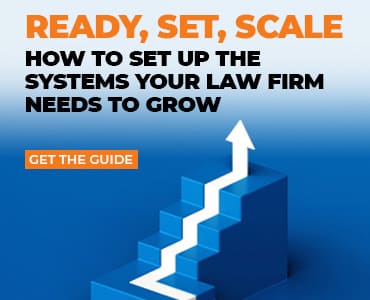Follow up email examples: Many lawyers get anxious about sending follow up emails to a prospective client. Here are some helpful tips.

Key Takeaways
- Balance Persistence and Patience: When sending follow up emails, you need to find the balance between persistence and patience. Don’t be too pushy and instead time your follow ups based on previous communication and the prospect’s response.
- Add Value: To not be too insistent, add value in your follow up emails. Share relevant blog posts or insights related to the prospect’s interests and keep you top of mind without asking for a decision.
- Address Them Directly: Personalization is key in follow up emails. Address them directly and tailor your message to their needs and interests.
Table of contents
When sending a series of follow-up emails to prospects, many lawyers get anxious about how well they’re balancing persistence against the risk of being perceived as pushy and turning off the prospect. This is a legitimate concern, and having a solid follow up strategy can help mitigate this issue.
However, you don’t have to walk on eggshells. As long as you do two things consistently, you won’t risk alienating anyone.
- At the conclusion of any contact, whether by phone or email, always ask, “What’s our next step?”
- Base each subsequent communication on that declared next step.
What is a Follow-up Email?
Definition and Purpose
A follow-up email is a message sent to someone you’ve contacted before, typically after an initial email or a particular stage in the buyer journey. The purpose of a follow-up email is to re-engage prospects, provide additional information, or request updates. It’s an essential tool in sales and marketing to nurture leads, build relationships, and ultimately drive conversions.
Importance of Follow-up Emails in Sales and Marketing
Follow-up emails play a crucial role in sales and marketing as they help to:
- Re-engage non-responsive leads and strengthen relationships
- Provide additional value and support to prospects
- Move opportunities forward in the sales pipeline
- Increase response rates and conversions
- Build trust and credibility with potential customers
Follow up Email: Did This Lawyer Get Too Pushy?
Here’s an actual example of a back-and-forth email thread between “Richard,” a lawyer I coach, and “Janice,” the representative of an industry organization with which he was trying to secure a speaking gig. In the end, he asks me if he pushed too hard in his previous email.
From: Richard [Lawyer who Mike coaches]
Sent: Monday, April 23, 2018, 10:48 AM
To: Janice [Trade group representative]
Subject: Reschedule our call?
Janice, Looks like this morning didn’t work out for our call. If you let me know another time that may work for you, I’m happy to reschedule at your convenience. Thanks!
Best, Richard
From: Janice
Sent: Monday, April 23, 2018, 11:03 AM
To: Richard
Subject: RE: Reschedule our call?
I’m so sorry Richard, I thought the appt was 10:30 central time so 11:30 est. Will 11:30 a.m. est work for you today?
Richard and Janice spoke by phone, followed by these email exchanges.
From: Richard
Sent: Wednesday, May 02, 2018, 9:33 AM
To: Janice
Subject: Next steps re [conference topic]
Janice, Thanks for your enthusiasm about the collaboration we’re exploring re: presentations, deeper dives. Next steps? Thanks!
Best, Richard
From: Janice
Sent: Friday, May 04, 2018, 1:27 PM
To: Richard
Subject: RE: Next steps re [conference topic]
Hi Richard — My colleagues and I have been traveling non-stop the past week and next week looks the same. We will be meeting towards the end of the week of May 15th so I should have an update for you then. Thanks and have a great weekend!
From: Richard
Sent: Tuesday, June 05, 2018, 12:27 AM
To: Janice
Subject: RE: Next steps re [conference topic]
Janice, I hope you are doing well. I wanted to touch base with you. Any thoughts on next steps? Thanks!
Best, Richard
From: Richard
Sent: Tuesday, June 19, 2018, 12:10 PM
To: Janice
Subject: RE: Next steps re [conference topic]
Janice, Since we last spoke, I’ve done some additional speaking on [topic] (e.g., at XYZ Org) and booked some additional future speaking engagements (e.g., ConfABC). If you want to see a sample of what the opening of one of my presentations looks like, here’s a link.
It seems like maybe the initial enthusiasm for having me speak to [Trade group] members has faded with time? Please let me know, thanks.
Richard
When things bog down, it’s a good idea to give the person the opportunity to pull the plug. If things have changed and it’s no longer a viable opportunity, you need to know that so you can disinvest. If the prospect has mentally moved away, you don’t want to be the only one still pursuing a dead idea.
From: Janice
Sent: Tuesday, June 19, 2018, 5:05 PM
To: Richard
Subject: Re: Speaking to [trade group] members re AI and alternative data
Thank you, Richard, for your email and update. No, I would not say there is a lack of excitement around this topic anymore, the program side of the conference is still identifying topics and no speaker invites have been sent out yet. I’m expecting to see something from them within the next two weeks or so so please stay tuned.
From: Richard
Sent: Tuesday, July 11, 2018, 2:30 PM
To: Janice
Subject: RE: Next steps re [conference topic]
Janice, I wanted to touch base and see if there was any update? Many thanks.
Best, Richard
From: Janice
Sent: Thursday, July 12, 2018, 9:14 PM
To: Richard
Subject: Re: Speaking to [trade group] members re AI and alternative data
Hi Richard, Thank you for your constant follow-ups. Invites still have not gone out yet for the breakout sessions on Annual but it does look like some other initiatives are starting to take precedent for this year. I will let you know if anything changes on our end but at this point, I don’t think this will work out for October.
Thanks, Richard, and please let me know if I can be of any additional assistance.
Janice
How to Write a Follow-up Email
A Personalized Greeting
A personalized greeting is key in a follow-up email because it sets a warm tone and shows you’ve taken the time to connect with the prospect on a personal level. By using their name, like “Hey David” or “Dear [name],” you make the interaction feel more genuine. You can also add a touch of personalization to subject lines, opening lines, and beyond by using tools like “spinning syntax” (spintax) and merge tags to make each email feel unique and thoughtful.
What Happened With These Follow-up email examples?
Here’s where Richard hit the panic button. You can see, though, why he felt like he might have pushed Janice away, prompting him to send me this email:
Just a quick reminder, based on our concept of making sure to follow-up and get decisions (and not letting things fall through the cracks), I’ve stayed on top of the opportunity below. However, I get the feeling I may have turned her off by pushing too much. I would have allowed more time and taken a softer approach in the past, but that might have its own downsides. Thoughts on this one, and on hitting the right balance in general? Thanks.
Here’s my response, assuring Richard that he actually did a very good job.
It’s possible, but I doubt it. Reviewing the thread:
- Your May 2 email appears to be in response to a phone conversation.
- Your June 5 email is in response to her volunteering that she’d have an update around May 15. You gave her two additional weeks of space.
- Two weeks after that, June 19, you inquired about the update she’d promised a month earlier.
- Her immediate reply said another two weeks and said “stay tuned.”
- You gave her three weeks, inquiring July 11.
- Her reply the next day is the long-promised update. It just wasn’t the one you expected or wanted.
I don’t see anything that I’d consider badgering in either your tone or frequency. The only thing you might consider in the future is mixing in some content relevant to her role and your topic, but unrelated to the speaking gig decision. That way, every message isn’t asking for an update, yet still subtly reminds her that she promised you one and keeps you associated with the topic about which you aspire to speak to her group.
Consider suggesting a quick call in your follow-up emails to clarify any questions or concerns she might have. This can encourage a timely response and position the call as a simple and efficient way to address her needs.
IMO, her email gives a different answer to your earlier “interest fading?” question. It’s fading relative to other priorities. Stay in touch with relevant content so that, when the idea resurfaces, she remembers you.
Remember that “yes” always comes fast; “no” usually takes much longer because people don’t like saying “no,” so they delay it, hoping that circumstances will make it unnecessary.
Negative outcomes aren’t necessarily evidence of error by you, any more than positive ones indicate genius.
Any sale is about the buyer’s interest; it’s rarely about you. My general philosophy is “whether social or business, the limits of progress in any relationship or endeavor are set by the person with the lesser interest.” That’s why selling is so hard. At least initially, sellers always want it more than buyers. That’s why we’re always trying to achieve the elusive balance between persistence and patience.
Richard exhaled in his reply and revealed what had triggered his anxiety.
Thanks. Really, I mean it — thanks. This is hugely helpful. Her comment “thanks for your constant updates” sounded to my ears like “you overzealous spamming pain in my butt.” But I’ll take it as “it is what it is,” thank her for letting me know, include my contact details for any follow-up questions, and send her unrelated content in a month or so.
Balance Progress Checks With Valuable Content
As you see from this timeline, the pacing of Richard’s emails wasn’t a problem. With the exception of his June 5th email, Janice replied to him every other time, either the same day or the next. It’s hard to interpret this as anything other than a very welcome exchange.
Where we risk alienating someone is by nagging them for a decision when they’re not ready to decide, or aren’t in the position to decide due to factors beyond their control, or there’s been a change in priorities.
Between progress-check emails, intersperse valuable content, such as a blog post, that isn’t pushing for a decision, and you’ll be fine.
Illustration ©iStockPhoto.com
Subscribe to Attorney at Work
Get really good ideas every day: Subscribe to the Daily Dispatch and Weekly Wrap (it’s free). Follow us on Twitter @attnyatwork.
Illustration ©iStockPhoto.com
















